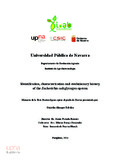Mostrar el registro sencillo del ítem
Identification, characterization and evolutionary history of the Escherichia coli glycogen operon
| dc.contributor.advisor | Pozueta Romero, Javier | es_ES |
| dc.contributor.advisor | Baroja Fernández, Edurne | es_ES |
| dc.creator | Almagro Zabalza, Goizeder | es_ES |
| dc.date.accessioned | 2018-08-02T07:44:30Z | |
| dc.date.available | 2018-08-02T07:44:30Z | |
| dc.date.issued | 2014 | |
| dc.date.submitted | 2014-07-03 | |
| dc.identifier.uri | https://hdl.handle.net/2454/29344 | |
| dc.description.abstract | Representing one of the major storage carbohydrate in many bacteria, glycogen is a branched homopolysaccharide of α-1,4-linked glucose subunits with α-1,6-linked glucose at the branching points that accumulates under conditions of limiting growth when an excess of carbon is available and other nutrients are deficient. The exact role of this polyglucan in bacteria is not as clear-cut as in animal and yeast cells, but some studies have linked glycogen to extended bacterial survival, symbiotic performance, colonization and virulence. It is widely accepted that genes involved in Escherichia coli and Salmonella enterica glycogen metabolism are clustered in two tandemly arranged operons: glgBX (encompassing the genes coding for glycogen branching (GlgB) and debranching (GlgX) enzymes), and glgCAP (encoding the GlgC and GlgA anabolic enzymes, as well as the catabolic glycogen phosphorylase (GlgP)). However, the data regarding regulatory aspects of the expression of glycogen genes in E. coli are contradictory, thus questioning the presence of two operons. To get inshight into the trascriptional organization of glycogen genes, in the first chapter of this work I characterized glg genes transcription using RT (reverse transcriptase)-PCR approach. This analysisW revealed that E. coli cells possess transcripts comprising the five glgBXCAP genes. glg::lacZY expression analyses in cells lacking the region immediately upstream of the glgB gene revealed an almost total abolishment of glgB, glgX and glgC expression and a reduced expression of glgA and glgP. Similar type of analyses showed that glgA and glgP expression was almost totally abolished in cells lacking glgA upstream sequences, including glgC, glgB and the asd-glgB intergenic region upstream of glgB. All the data indicate that the five glgBXCAP genes are transcribed in a single transcriptional unit under the control of promoter sequences upstream of glgB and that an alternative suboperonic promoter driving glgA and glgP expression is located within glgC. Using computer searches for putative bacterial promoters and 5¿ RACE (rapid amplification of cDNA ends) techniques I identified the -35 and -10 sequences of both promoters as well as the trasnscription start sites. Finally, I measured glg::lacZY expression on cells lacking the relA or phoP regulatory genes. These analyses indicated that both glgBXCAP operon and the suboperonic promoter form part of RelA and PhoP-PhoQ regulons. To gain insight into the origin and evolutionary history of E. coli glgBXCAP operon and of its constituent genes, in the second chapter of this work I carried out a detailed comparative analyses of presence, copy number and arrangement of glg genes in 265 gammaproteobacterial species. These analyses revealed the occurrence of large variations in glg homolog copy number and arrangements. Subsequently, I carried out a phylogenetic analysis of glg genes of selected Gammaproteobacteria and I also explored the phylogenetic relationships of gammaproteobacterial glg genes with those of representative species of the main bacterial groups. I found an important discrepancy between the evolution of glg genes and the order of organismal descent, inferred from 16S rRNA analysis, indicating that glg genes have undergone a complex evolutionary history in which horizontal gene transfer have played an important role. However, I detected a notable exception constituted by Enterobacteriales/Pasteurellales (E/P) glg genes which show a strict vertical inheritance. These analyses also revelaed that E/P glg genes are related with glg genes of phylogenetically distant betaproteobacterial species Varivorax paradoxus S110, Thiomonas intermedia K12, Lepthotrix cholodnii SP-6 and Thauera mz1t. The genomic context analysis indicated that the glgBXCAP arrangement is conserved in the E/P group and interestingly, that the above mentioned betaproteobacterial species possess glgBXCAP and/or gene clusters very similar to glgBXCAP. The overall data allowed me tracing the evolutionary origin of glgBXCAP operon in the last common ancestor of the E/P group and suggest a possible horizontal gene transfer event of the glgBXCAP cluster from the E/P group to Betaproteobacteria. | en |
| dc.description.sponsorship | Este trabajo ha sido financiado por los proyectos BIO2007-63915 y BIO2010-18239 de la Comisión Interministerial de Ciencia y Tecnología. | es_ES |
| dc.format.extent | 179 p. | |
| dc.format.mimetype | application/pdf | en |
| dc.language.iso | eng | en |
| dc.relation.uri | https://biblioteca.unavarra.es/abnetopac/abnetcl.cgi?TITN=494396 | |
| dc.subject | Antibióticos | es_ES |
| dc.subject | Bacterias | es_ES |
| dc.subject | Escherichia coli | es_ES |
| dc.subject | Antobiotics | en |
| dc.subject | Bacteria | en |
| dc.subject | Escherichia coli | en |
| dc.title | Identification, characterization and evolutionary history of the Escherichia coli glycogen operon | en |
| dc.type | info:eu-repo/semantics/doctoralThesis | en |
| dc.type | Tesis doctoral / Doktoretza tesia | es |
| dc.contributor.department | Producción Agraria | es_ES |
| dc.contributor.department | Nekazaritza Ekoizpena | eu |
| dc.rights.accessRights | info:eu-repo/semantics/openAccess | en |
| dc.rights.accessRights | Acceso abierto / Sarbide irekia | es |
| dc.description.doctorateProgram | Programa Oficial de Doctorado en Biotecnología (RD 1393/2007) | es_ES |
| dc.description.doctorateProgram | Bioteknologiako Doktoretza Programa Ofiziala (ED 1393/2007) | eu |


